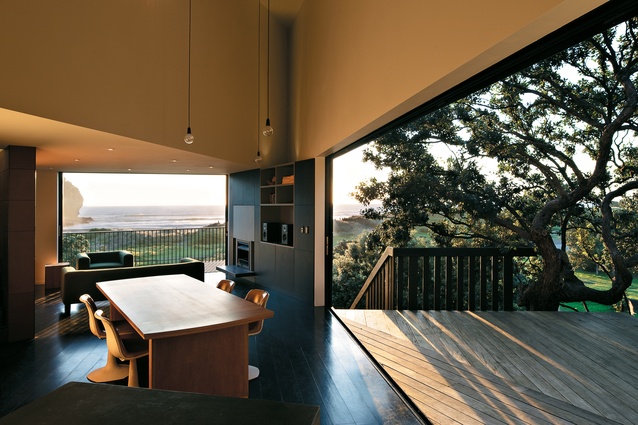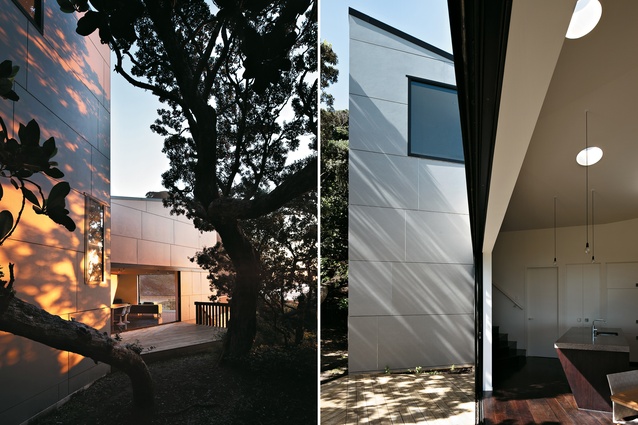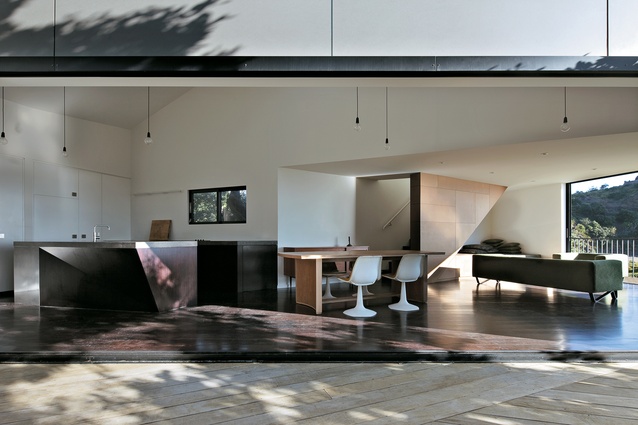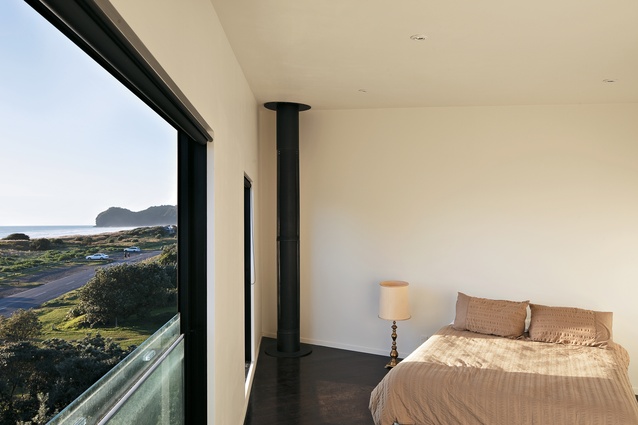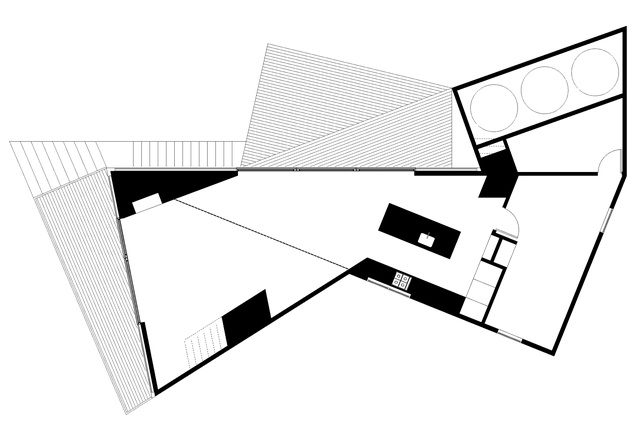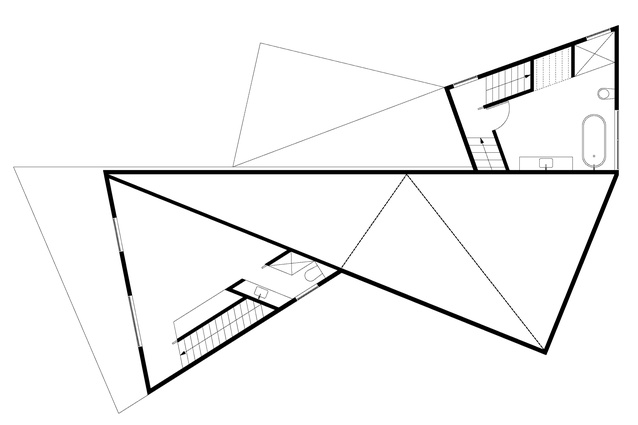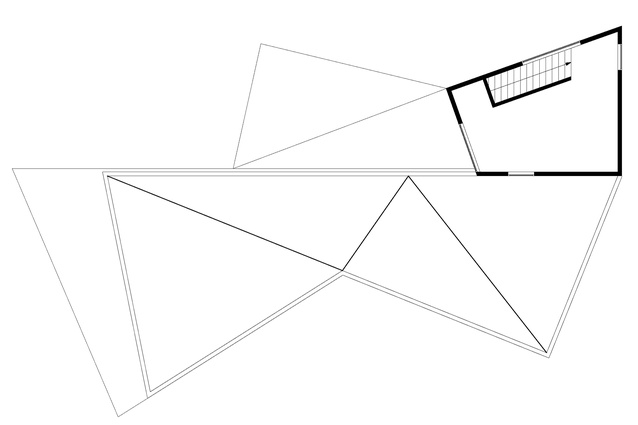Houses Revisited: Complex solution
We look back at a bach on Auckland’s West Coast in which Matthew Gribben pursues an unorthodox design solution.
Unlike most of the houses that sit directly across the road from Piha’s beach, which tend to sit low and cower into the steep cliffs behind them, the beach house designed by Matthew Gribben of Sydney-based firm Matthew Gribben Architecture stands two-storey tall atop a timber pedestal. Pushing through the blanket of trees that cover the cliff behind it, the house’s confident stature creates a strong relationship with Piha’s Lion Rock. The house’s atypical height – for this area – has a logical explanation: it’s a way to make the most of the coastal views while increasing privacy.
To further increase the occupants’ privacy, and to allow the bach to be closed up when not in use, Gribben has designed full-height moveable screens that cover the sliding doors on the northern and western (front) elevation. The screens are largely indistinguishable from the grey, rectangular fibre-cement sheet façade; the strongest hint that these screens do open up is the front balcony, that would otherwise be rendered superfluous.
The timber pedestal on which the house sits creates a large storage space underneath and raises the entry to the house up to the equivalent of first-storey height. A staircase on the exterior of the house takes you up to a large and reasonably private balcony space surrounded in mature pohutukawa.

It is once you begin to walk up the side of the house that you become aware of the house’s twisted and faceted form. Gribben explains that this form was conceived out of consideration for the pohutukawa. It was through an extensive mapping of the trees’ positions that the architect derived the house’s form as a geometry that would fill the residual space “like a glove,” and make an extended reference to the trees’ overgrown, twisted and knotted limbs.
The entrance to the house is unassuming and informal. Although it is implied that you should probably go up the exterior stairs to get into the house, once you reach the balcony the position of the front door is rather ambiguous. Like the front façade, the doors that run along the private balcony are covered by external sliding screens that require a rather strong heave to shift.
Once the screens and the glass sliding doors have been opened the house begins to engage more noticeably with the landscape. Entry is into a casual open-plan room, containing the kitchen, dining and living spaces, although entering this house is not the usual ingress experience due to those screens on the front façade.
It is not until you open these screens that the interior space and its connection with the landscape can be fully appreciated. As with travel luggage, the house essentially requires unpacking before you can get comfortable. However, once all of the screens are pulled back, this area is, because of the faceted form, where most of the spatial excitement is experienced.
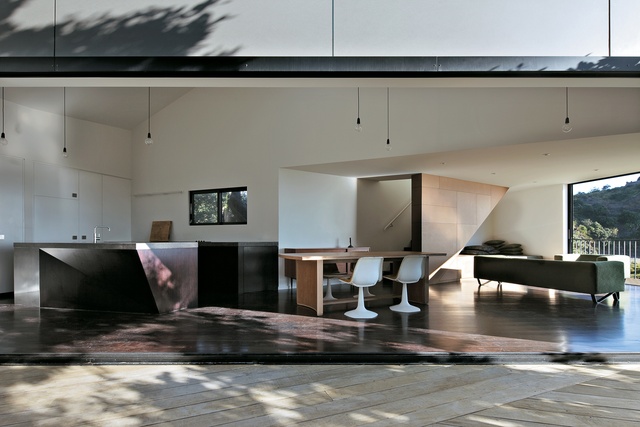
The angular roofscape and twisted plan aid in distinguishing between the uses of the spaces; the roof soars upwards in a gesture that makes you look out towards the sea, and in areas where intimate and workable spaces are required, the roof descends.
Many of the finishing elements within the faceted and dramatic space have been added through spherical, circular and curved details, “in order not to compete with the angular geometry”, Gribben explains. Circular skylights in the roof bring natural light into the reasonably deep plan; low-hanging spherical light bulbs give a sense of the increase in ceiling height; curved lips on the stair treads and a circular stair railing accentuate the strength of the main form’s facets.
The conceptual form, besides being a response to the clients’ desire for comfortable, multi-generational habitation, has meant that two staircases at either end of the open plan space are used to access two separate first-storey spaces. The first staircase, which peels away from eastern wall and runs alongside the living space, leads up to the main the bedroom and projects out towards the beach, offering views of Lion Rock.
At the back end of the open plan space, at ground level, is a bunk-room; running alongside this is another set of stairs leading to a bathroom on the first level, and then to a bedroom on the second level. Having to work a little harder to get to this bedroom, I expected a grand outlook, but the views I did experience were mostly of the first bedroom’s roof. As Gribben explains, “it was decided to use the house as a way to create privacy”.
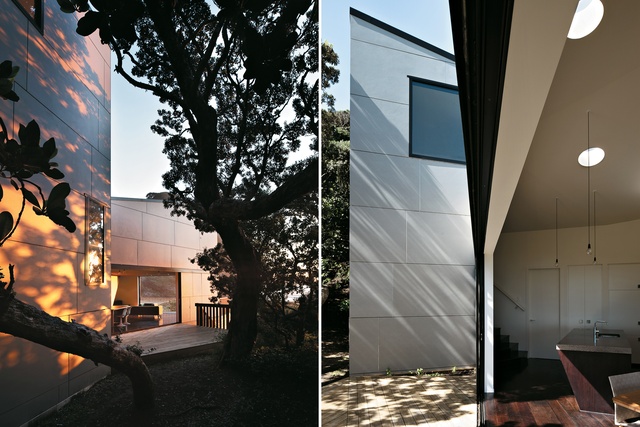
The architect believes that the architectural language is sufficiently strong that it justifies the obstruction of views of the coast, surely one of this site’s best assets. On some level, the pointed inorganic shape does work to create a relationship with Lion Rock.
Although the complex geometry of the form creates stimulating moments of space, it is not without its hindrances. At times it seems that the faceted, twisted concept has forced unwieldy design decisions. “The geometry is defined by non-negotiables, that is, the position of the trees,” Gribben says. “It was the architecture that was forced to adapt.”
The architect acknowledges the difficulties associated with this fractal form: “Due to the complex geometry, we discovered that when a minor adjustment is made in one area for a specific purpose, unintended effects occur throughout”.
This house is quite different to most of the houses I have visited. The interior spaces shaped by a highly conceptual faceted and twisted form certainly diverge from the familiar rectangular box. The house offers spatial excitement and interesting architectural moments, even if, at times, the execution of the concept seemed to fray at the edges.
While the architect cited extensive consideration of the site and the creation of privacy as the main drivers for this house, to me the building reads at least as strongly as a piece of architecture created out of the pursuit of of an idea which he was strongly committed to explore.
This article first appeared in Houses magazine


